Section 6.1. BPMN
6.1. BPMNBPMN is a graphical flowchart-like language intended for use by business analysts and developers to build business process diagrams (BPDs) . A BPD conveys in pictures what BPML and BPEL encode in XML, but it serves a different purpose: BPMN is for graphical design, whereas BPML and BPEL are for execution. The BPMN specification[
In addition to BPEL export, the tool also supports BPSM metamodel import and export, allowing the BPMN tool to exchange processes with those developed in other tools. The message broker example developed in Chapter 11 uses ITpearls' MS Visio-based BPMN tool for the design of message broker processes. ITpearls, alas, does not currently include any of these import and export features. Figure 6-2. Use of BPMN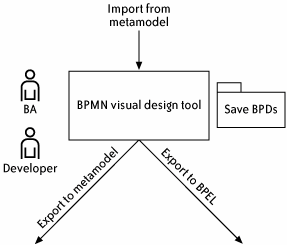 6.1.1. BPMN ExampleThe first step in learning a new language is to look at the implementation of "Hello, World!" In our case, we study "Hello, Claim!," which is an insurance claims handling process and is shown in Figure 6-3. The process receives a claim (Get claim), examines it (Examine claim), and then splits into one of three directions, depending on whether the claim has been approved (Process approval), rejected (Process reject), or passed along for further analysis (Analysis). The analysis option has a time limit; if it is not performed quickly enough, it is aborted (Stuck), and a special escalation process (Escalate, whose steps are enclosed in the Escalate box) is run. The escalation process behaves much like its parent: it begins by examining the claim, then either approves or rejects it; no further analysis is permitted in an escalation. The parent process completes when its conditional pathapproval, rejection, analysis, or escalationcompletes. Several types of symbols are used in this diagram: events, gateways, atomic activities (or tasks), compound activities (or subprocesses), sequence flow, and text annotations. Events, drawn as small circles, mark the start (e.g., Get claim) and end points of the process, as well as the intermediate timeout condition (Stuck) that occurs during analysis. Gateways (diamonds) help mark the conditional split and join portion of the process. Activities (boxes) represent actual work performed. Tasks (e.g., Examine claim) are single actions, whereas subprocesses perform arbitrarily complex logic. A subprocess can be drawn either collapsed or expanded; a collapsed process (e.g., Process reject) is drawn with a plus sign, its details hidden, but assumed to be documented in another diagram; an expanded process (e.g., Escalate) has its internal logic drawn inside of it. Sequence flow is the set of arrows connecting together the other pieces; arrows labeled with text (e.g., arrow between gateway and Process approval) are conditional, followed only if the condition is true. Text annotations (open-ended boxes) present instructional comments. Figure 6-3. BPMN insurance claims process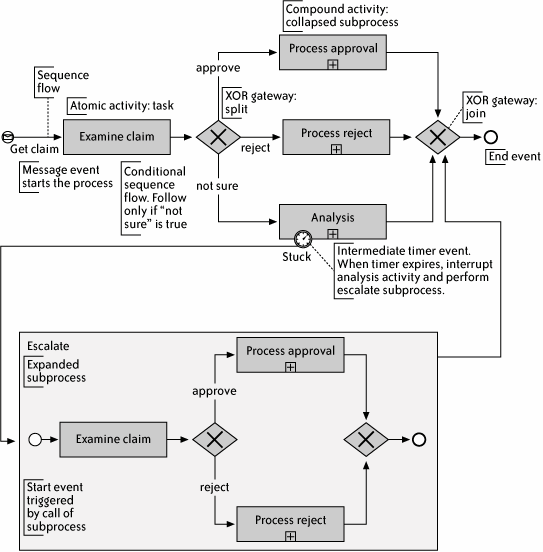 6.1.2. BPMN in a NutshellThis section examines the essential language constructs that designers need to understand in order to create a BPMN process: the basic process structure, variables and assignments, exception handling and compensation, split and join, loops, participant exchange, transactions, and extensions. Before delving into the details of the language, we'll first introduce the basic elements in a BPMN processevents, activities, sequence flows, and gatewaysin a bit more detail. An event, the first basic element of BPMN, is an occurrence that triggers a business process. Events are categorized by the stage at which they occur in a process (start, intermediate, or end) and by type (basic, message, timer, rule, exception, cancellation, compensation, link, multiple, or termination). The shape of an event is a small circle; a start event has a thin border, an end event a thick border, and an intermediate event has a double border. Figure 6-4 illustrates the complete set of events and how they are depicted. Table 6-1 describes the role of events in more detail. Figure 6-4. BPMN events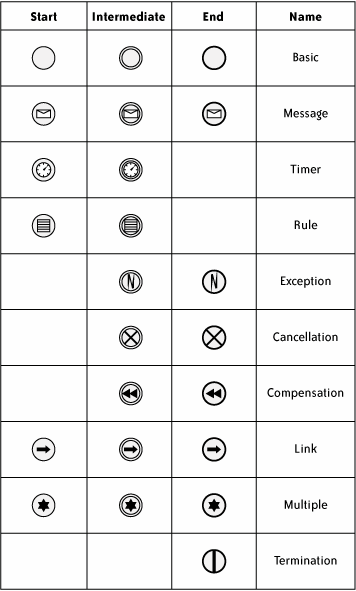
An activity, the second basic element of BPMN, is a step in a process that performs work. In BPMN, an activity is either atomic or compound. An atomic activity, also known as a task, performs a single action. A compound activity, also known as a process, has its own set of atomic or compound activities , as well events, gateways, and all other BPMN constructs. Processes are hierarchical: a process can have subprocesses, each of which can have subprocesses, and so on. An activity is drawn as a box with rounded edges. When shown in a parent process, a child process is drawn as a single box bearing a plus sign (+). The plus sign represents the collapsed view of the process; the full detail is drawn in a separate diagram. Any activitytask or processcan be marked up with symbols representing compensation, multiple instances, and loops; additionally, a process can have the markup symbol tilde (~) for ad hoc processing. These possibilities are depicted in Figure 6-5. Figure 6-5. BPMN activities A compensated activity is one that has special compensation logic to revert it (undo its effect) after completion. An ad hoc process contains a set of activities that can occur in any order; the control flow is unstructured. Loop and multiple instance activities are described in the later section "Loops." Table 6-2 summarizes the BPMN specification's suggested task types.
Sequence flow, the third basic element of BPMN, is the flow of control in a process, and is represented by arrows connecting source and target activities, events, or gateways. Figure 6-6 shows the three types of sequence flow arrows. Figure 6-6. BPMN sequence flow arrows The first arrow represents normal, unguarded flow from source to target. The second symbol is default flow, used in cases where control splits into multiple directions, each path depending on the evaluation of a condition; it fires only if none of the other guarded transitions fired. The third is a guarded transition, traversed only if its associated conditional expression evaluates to true; the diamond at the end of the arrow is not required when the transition originates from an XOR split. A gateway, the final basic BPMN element, is a special controller of splits and joins. This element is discussed in more depth in the later section "Split and join." 6.1.2.1 Basic process structure: start, end, activities, sequenceA basic BPMN process has a start event , one or more activities, and an end event. The process in Figure 6-7, for example, starts with a message event that receives a partner request, and then executes activities to handle the request and send a response to the partner, before closing with a basic end event. Figure 6-7. BPMN sequence example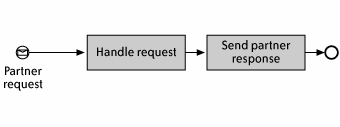 Besides activities, intermediate events can also be key steps in the mainline sequence of a process. A typical example is the process shown in Figure 6-8, which sends a message to a partner application and then needs to waits for response before continuing. This example also shows that the end event can perform useful work; in this case, sending an acknowledgment message to the partner. Figure 6-8. BPMN sequence example with intermediate event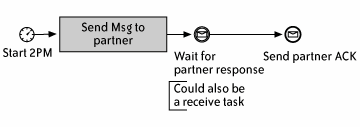 6.1.2.2 Variables and assignmentsIn BPMN, processes and activities can have variables (known as properties), assign values to them, and make decisions based on their values. Though variables are not shown graphically in a BPD, BPMN includes them in its object model, chiefly to facilitate a mapping to BPEL. Most BPMN editors, including ITpearls, provide an attribute editor to manipulate variables and other data associated with processes, activities, or other graphical nodes. Figure 6-9 shows how two String type propertiesClaimID and SubscriberIDaredefined for the Escalate subprocess. Figure 6-9. BPMN process properties in ITpearls' attribute editor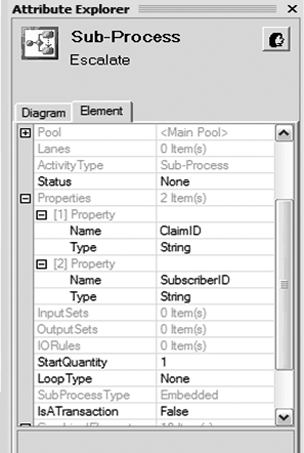 For the mechanics of variable usage, consult the BPMN specification. 6.1.2.3 Exception handling and compensationFigure 6-10 illustrates the BPMN approach to exception handling. Figure 6-10. BPMN exception handling Part (a) shows the catching and handling of an exception in the subprocess Enroll customer. When Enroll customer completes normally, it transitions to Send welcome package. But if an exception occurs during its execution, the intermediate error event on the boundary of Enroll customer catches the error and passes control to the subprocess Fix, which serves as a fault handler for Enroll customer. Part (b) shows that an intermediate error event, when not on the boundary of an activity, effectively throws an exception, which triggers exception handling of the parent process. The event Throw bad credit breaks the normal flow of the parent process, Enroll customer, and precipitates the handler in Fix from part (a). In compensation, an activity is run to reverse the effects of another activity. For example, in Figure 6-11, Cancel compensates Reserve hotel. Figure 6-11. BPMN compensation The notation is to place a compensation intermediate event (resembling a "rewind" symbol) on the boundary of the activity to be compensated, draw a dotted arrow (known as an "associated" in BPMN parlance) from the compensation event to the boundary of the compensating activity, and mark a compensation symbol inside the boundary of the compensating activity. The compensating activity must be self-contained; it cannot have any inbound or outbound sequence flow connections. The job of a compensating activity is strictly to perform the required reversal logic. Compensation is triggered in one of two ways:
Compensation can apply to transactional and nontransactional activities alike. For transactional activities, compensation is not the same as rollback. Only a completed activity can be compensated; if that activity is transactional, because it has completed, its transaction has already committed. 6.1.2.4 Split and joinBPMN uses the gateway element to model split and join patterns, which represent common programming control structures such as if-then, switch, and all. A gateway branches and merges paths in a process. The diamond-shaped symbol is well known in flowchart languages as a decision point, but BPMN expands its use to model patterns such as AND split and join and deferred choice. Furthermore, in BPMN a gateway has two modes: it splits one incoming path into multiple outgoing paths (which we will refer to as split mode), and merges several incoming paths into one outgoing path (join mode). The BPMN gateway symbols are shown in Figure 6-12. Figure 6-12. BPMN gateways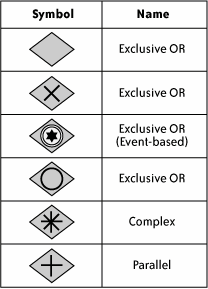 The first gateway, the exclusive OR, uses if-then-else and switch with mutually exclusive cases as a control structure. In split mode, it evaluates a separate condition on each of its outgoing paths and lets through the first path whose condition evaluates to true; all others are ignored. Exactly one condition must be true; a default branch can be specified in case none of the other branches fire. In join mode, the exclusive OR gateway lets through the first of its multiple incoming branches and discards all others. Figure 6-13 illustrates the behavior by showing an activity (Finalize claim) that runs when either Process approval or Process rejection completes, and an activity (Evaluate claim) that splits to Process approval if the condition approved is satisfied and to Process rejection otherwise. Figure 6-13. BPMN exclusive OR gateway The second gateway, the exclusive OR (event-based), uses a pick control structure. In split mode, each outgoing branch leads to an event node. The gateway lets through the branch having the first triggered event, and ignores all others. The join mode is not commonly used. For example, in the process in Figure 6-14, when the activity Request completes, the process waits for one of the two eventsReceive accept or Receive rejectto occur. Figure 6-14. BPMN exclusive OR gateway for events The third gateway, the inclusive OR, uses a switch with overlapping cases as a control structure. The split mode is similar to exclusive OR but lets through each outgoing path whose condition evaluates to true. The join mode blocks passage until each expected executing incoming path enters it. The gateway knows in advance how many active inputs to expect. Figure 6-15 illustrates both behaviors: activity Get employee change splits to Send to HR or Send to payroll or both, depending on the evaluation of conditions promotions and raise; activity Log change waits until Send to HR or Send to payroll or both of these complete, depending on which paths the splitting gateway let through. Figure 6-15. BPMN OR gateway The fourth gateway, complex, uses a control structure that is quite unique to BPMN. The split mode is not commonly used. The join mode evaluates an expression to determine which of the incoming paths to let through. As an example, in Figure 6-16 the gateway waits for two of the three parallel activitiesGood credit, Natural citizen, and No criminal recordbefore granting security clearance. Figure 6-16. BPMN complex gateway The final type, the parallel gateway, uses all control structures in BPML and flow in BPEL. In split mode, it lets through each outgoing path. In join mode, it blocks until each incoming path completes. Figure 6-17 illustrates these two behaviors: when activity Accept claim completes, the activities Send email result and Credit subscriber bank account are run in parallel; Mark claim done, however, starts only when both Send email resultand Credit subscriber bank account complete. Figure 6-17. BPMN AND gateway NOTE The BPMN specification is laden with references to token passing, betraying its dependency on the ideas of the Petri net. For example:
6.1.2.5 LoopsBPMN's approach to looping is powerful but obscure. In most process languages, a loop is a specific type of compound activity that iterates over the set of activities inside of it. For example, the BPEL while loop in the following code sample repeats a sequence of invoke activities (A and B) for as long as its specified condition evaluates to true: <while condition=". . ."> <sequence> <invoke name="A" . . . /> <invoke name="B" . . . /> </sequence> </while> In BPMN, looping is an attribute of an activity. To make an activity loop, simply play with the attributes of the activity, and it will loop as directed. If BPEL were designed this way, its code would resemble the following, in which the sequence activity itself controls whether and how to loop: <sequence looping="true" loopcondition=". . ."> <invoke name="A" . . . /> <invoke name="B" . . . /> </sequence> In BPMN, any activity (either a task or a subprocess) can be configured either to not loop, to loop in standard mode (while or until loops), or to support multiple instances (foreach looping). The notation for standard and multiple instance (MI) loops is shown in Figure 6-18. (An activity with standard looping has a circular arrow mark in the bottom center of its box; an activity with MI has a pair of vertical parallel bars.) Figure 6-18. BPMN notation for standard and multiple instance (MI) loops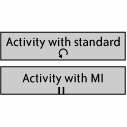 Figure 6-19 shows the BPMN representation of the BPEL while loop: activities A and B run sequentially in a process AB sequence that is configured with standard looping. Figure 6-19. BPMN while loop for a sequence of activities Table 6-3 summarizes the settings for a standard loop.
If the test time is set to before, the logic of the loop is the following: While (cond and loopCounter < maxLoops) Perform Activity Otherwise, the logic of the loop is the following: Do Perform Activity Until (cond and loopCounter >= maxLoops) In contrast to the standard loop, the MI loop is rather complicated. Table 6-4 summarizes the MI loop settings.
Sequential processing is simple: For counter = 0 to MI condition Perform activity Perform next activity Parallel processing with a flow condition of all resembles the following: For counter = 0 to MI condition Spawn activity Wait for all activities; when an activity completes, do nothing Perform next activity Parallel processing with a flow condition of one resembles the following: For counter = 0 to MI condition Spawn activity Wait for one activity; when it completes, perform the next activity Parallel processing with a flow condition of none resembles the following: For counter = 0 to MI condition Spawn activity Wait for all activities; for each completed activity, perform next activity Parallel processing with a flow condition of complex resembles the following: For counter = 0 to MI condition Spawn activity Wait for all activities For each completed activity If complex condition says perform next activity, do so Figure 6-20 shows scenarios in which each type of looping would be used. Figure 6-20. BPMN loop scenarios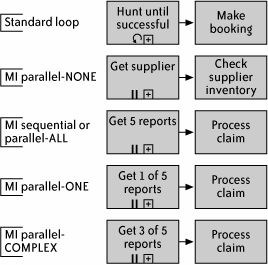 Table 6-5 summarizes each of these scenarios.
6.1.2.6 Participant exchangeBPMN provides a rich framework for modeling interparticipant processing, which includes swim lanes and pools, message flow, message events, send and receive tasks, and message correlation. A swim lane is a pool and each of its lanes. A pool represents the activities of one participantoften a companyin collaboration; a lane in a pool represents a subdivision of the participantoften a department or division of the company. Swim lanes help convey the sense that a process spans multiple participants; it depicts who does what and how the interactions are structured. For example, consider the collaboration of a supplier and a financial institution. The supplier calls the financial institution to authorize payment. The supplier, in turn, is divided into sales and distribution departments, which manage different parts of the supplier's process. Figure 6-21 illustrates this scenario. Figure 6-21. BPMN swim lane, adapted from BPMN specification, V.1, p.104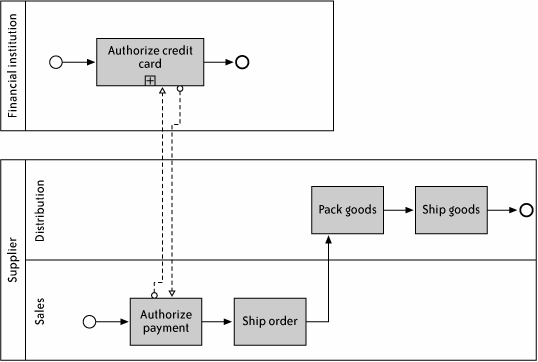 Message flow, symbolized by a dashed arrow, such as the arrow between supplier and financial institution in Figure 6-21, shows the flow of messages, or the data flow, between participants. The solid arrows of sequence flow, by contrast, capture process flow, or inter-activity control movement. NOTE The BPMN authors favor showing both kinds of flow in the same diagram, but this practice has drawbacks, the most obviously of which is clutter. Showing both types of flow is also common in UML activity diagrams. Message events and send and receive tasks are also supported. Table 6-6 summarizes the five main BPMN message -exchange process elements and their BPEL mapping.
BPMN's support for message correlation (which allows a process to determine whether a given inbound message, based on key data, belongs to its conversation) is something of an afterthought. Specifically, BPMN allows a process or activity property to be designated as a correlation set. Such a property can have child properties that represent members of the correlation set. Refer to the BPMN specification for the mechanics of the approach. 6.1.2.7 TransactionsBPMN also supports the notion of the transaction, in which a subprocess can be marked to allow it to be executed as a single unit of work. If the subprocess reaches its end point successfully, it is committed. If it receives a cancellation event, the transaction is rolled back, compensation is applied to any subactivities that require it, and a special cancellation handler is executed. A transactional subprocess is drawn with a thick border line. The cancellation handler is connected by a sequence flow to an intermediate cancel event on the border of the subprocess. As an example, in Figure 6-22, if a cancellation occurs in the transactional subprocess Invite to conference, the updates in Add to meeting list and Add to dinner list are rolled back, the Reserve hotel activity is compensated, and the cancellation handler Manual fix is executed.
Figure 6-22. BPMN exception handling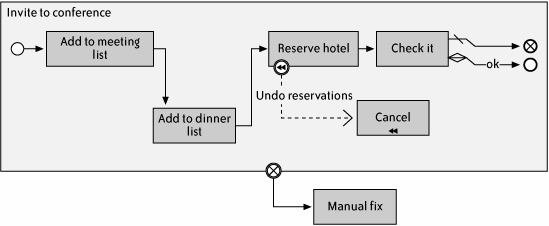 A cancellation can be triggered either explicitly, by a cancellation end event in the subprocess, or implicitly, by a cancellation message from the transaction manager of the engine. The use of a cancellation event is shown in Figure 6-22: when the Check it activity is executed, it transitions to one of two end events: a normal end, if the variable ok evaluates to true, or a cancellation event, which cancels the subprocess. 6.1.2.8 ExtensionsBPMN can be extended in two ways: by adding new symbols or by modifying existing symbols. Considering the importance of BPMN's mapping to BPEL (discussed in the next section), a key BPMN extension follows the BPELJ extension of BPEL by providing Java variables and expressions, Java-based participants, and Java-based message events and send and receive tasks. These changes would be noninvasive, affecting only the behind-the-scenes attributes of core BPMN constructs, with no impact to the visual representation. 6.1.3. BPEL MappingThe BPMN specification includes a 64-page chapter on BPEL mapping , which bridges the gap between graphical design and executability. BPMN diagrams are of little consequence unless they can actually be deployed and run. The BPEL mapping allows the generation of BPEL XML from BPMN diagrams, thus making it possible to run BPMN on BPEL engines. Significantly, the BPMN specification omits, and makes no mention of, a mapping to BPML; the BPMI, as described previously, places BPEL on its stack in place of BPML. The details of the mapping are difficult. This section is a very high-level overview; you should consult the BPMN specification for the complete picture. BPEL has fewer constructs than BPMN, which complicates the mapping. One of the weaknesses of BPMN is its excess of features (e.g., multiple instance activities and the complex gateway); this excess makes BPMN extremely expressive, but a chore to fit into the BPM stack. BPSM, described at the beginning of this chapter, might help close the gap by providing a common metamodel for these languages. Table 6-7 presents the highlights of the mapping presented in the BPMN specification.
6.1.4. BPMN and PatternsBPMN is designed to implement most of the P4 patterns discussed in Chapter 4. White's paper[*] describes the BPMN implementation for each of the patterns. Table 6-8 summarizes White's findings.
|
EAN: 2147483647
Pages: 122
- Chapter Eleven Gaining Access to People with Power
- Chapter Thirteen Closing: Reaching Final Agreement
- Chapter Fourteen Getting Started with the Process
- Chapter Fifteen Sales Management System: Managers Managing Pipelines and Salespeople
- Chapter Sixteen Creating and Sustaining High-Performance Sales Cultures
 ] attempts to bridge the gap by providing a mapping from BPMN to BPEL (but not, interestingly, to BPML); the mapping specifies rules to generate BPEL from a BPD, enabling the execution of a BPD. Figure 6-2 shows how a typical BPMN tool is used in the design process.
] attempts to bridge the gap by providing a mapping from BPMN to BPEL (but not, interestingly, to BPML); the mapping specifies rules to generate BPEL from a BPD, enabling the execution of a BPD. Figure 6-2 shows how a typical BPMN tool is used in the design process. ] S. White, "Business Process Modeling Notation,
] S. White, "Business Process Modeling Notation,